Wasps, both yellow and black, are among the most intriguing insects on the planet. Many people fear and misunderstand them because of their stunning color and menacing stingers.
These insects, however, serve a crucial function in the environment, acting as pollinators, predators, and even biological pest control agents.
In this post, we’ll learn about the interesting world of yellow and black wasps, including their numerous species, habits, and adaptations. Whether you are a scientist, a nature enthusiast, or simply interested in the natural world, this article will present fresh insights and respect for these incredible insects.
1. Yellow Jacket Wasps

These black and yellow wasps are known for their aggressive behavior and painful stings.
©Henrik Larsson/Shutterstock.com
You’re in for a treat because we’re discussing the notorious yellow jacket wasps! These black and yellow wasps are known for their aggressive behavior and painful stings. Yellow jackets are social wasps, meaning they live in colonies and have a strict hierarchy. The queen yellow jacket is responsible for laying eggs, while worker yellow jackets take care of the nest and gather food.
These wasps are known to be omnivorous, feeding on both nectar and other insects. They are also attracted to sweet foods and drinks, making them common guests at picnics and outdoor gatherings.
They are known for aggressively defending their colony and will not hesitate to sting perceived threats. Yellow jackets are responsible for many allergic reactions and even yearly deaths.
Despite their dangerous reputation, yellow jacket wasps play an important role in the ecosystem. They help control populations of other insects and are also important pollinators. So, while it’s important to be cautious around these black and yellow-striped insects, we can also appreciate their vital role in the natural world.
2. Paper Wasps

Paper
wasps get their name from the paper-like material they use to build their nests
.
©iStock.com/tenra
Unlike yellow jackets, paper wasps are not as aggressive and will only sting if they feel threatened.
Paper wasps get their name from the paper-like material they use to build their nests. They create these nests by chewing wood fibers into a papery pulp, shaping them into hexagonal cells for their young.
They have a caste system similar to yellow jackets. The queen paper wasp is responsible for laying eggs, while the worker paper wasps take care of the nest and gather food.
Paper wasps are also known for their unique coloring, which can vary from species to species. Some have black and yellow stripes, while others have black and white stripes or metallic blue or green colors.
3. Mud Dauber Wasps
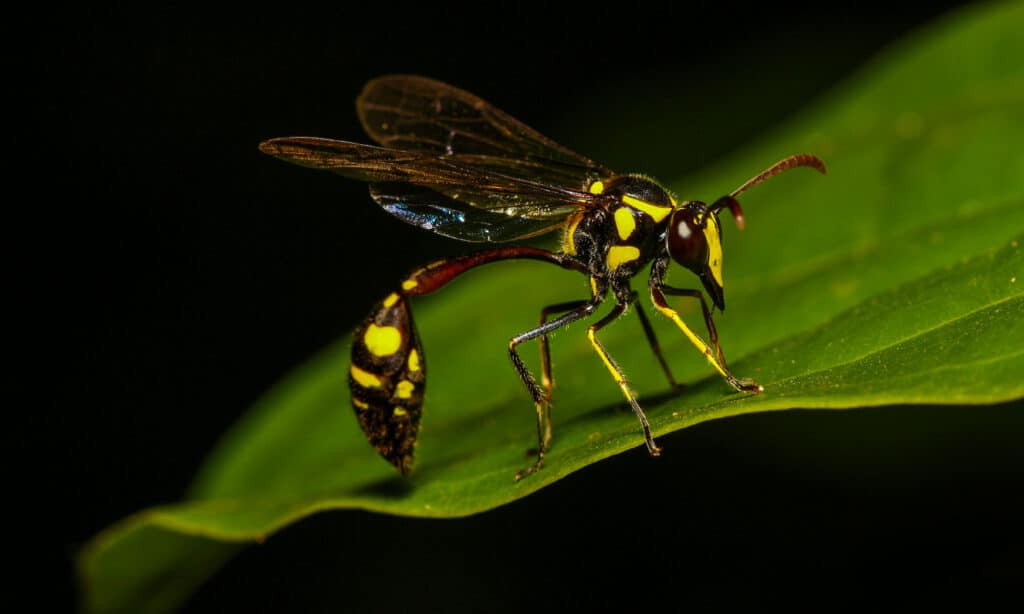
Mud dauber wasps are solitary creatures, meaning they don’t
live in large colonies like yellow jackets or paper wasps
.
©Preecha Ngamsrisan/Shutterstock.com
Let’s talk about mud dauber wasps, a black and yellow wasp that gets its name from how it builds its nests. These wasps are mud daubers because they use mud to build their nests.
Mud dauber wasps are solitary creatures, meaning they don’t live in large colonies like yellow jackets or paper wasps. Instead, each female wasp builds her nest and raises her young alone.
They hunt and capture spiders, which they paralyze with their venom and then use as food for their young.
Mud dauber wasps are also distinguished by their distinctive black and yellow coloring. Their bodies are long and thin, with a tight waist that gives them a wasp-like look.
While mud dauber wasps can be valuable as natural pest control agents, they can also be a nuisance if their nests are built near human houses. On the other hand, mad dauber wasps are intriguing animals worth learning more about due to their distinct activities and stunning looks.
4. Potter Wasps
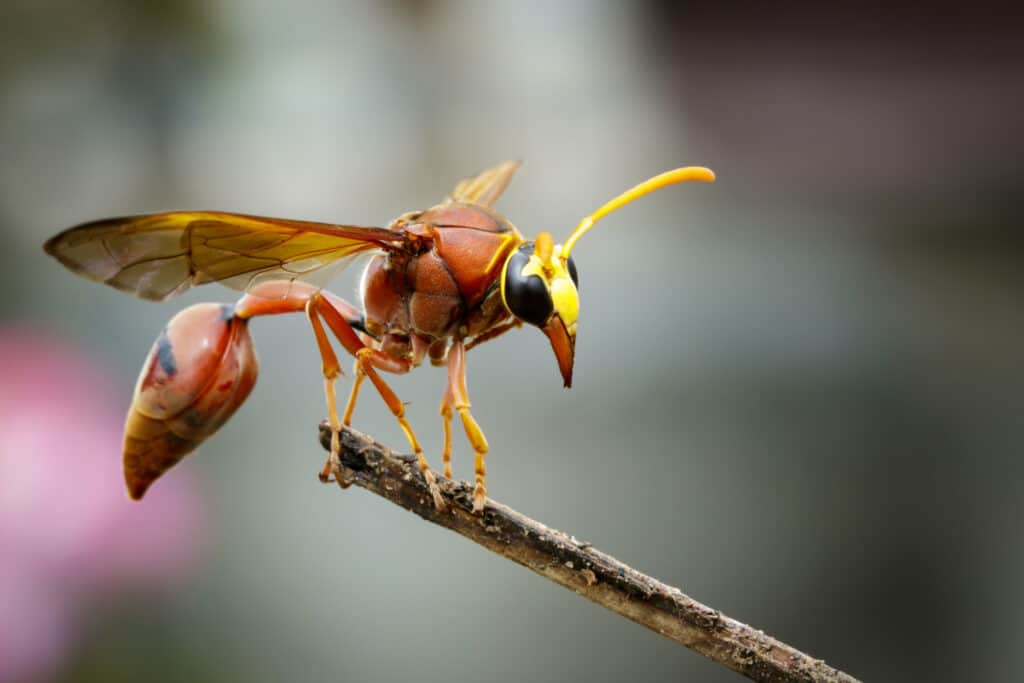
Potter wasps are known for their intricate and delicate nests, often adorned with intricate designs and patterns.
©iStock.com/yod67
As their name suggests, these wasps build small, vase-like pots out of the mud to lay their eggs and rear their young.
Potter wasps are known for their intricate and delicate nests, often adorned with intricate designs and patterns. They are also solitary creatures, meaning that each female potter wasp builds her own nest and raises her young alone.
They primarily hunt and capture caterpillars, which they paralyze with their venom before carrying them back to their nests as food for their young.
Potter wasps are also known for their striking black and yellow coloration, which can vary in pattern and intensity between different species. They have long, slender bodies with narrow waists and long legs.
Despite their intimidating appearance, potter wasps are generally not aggressive toward humans and will only sting if they feel threatened.
5. Cicada Killer Wasps
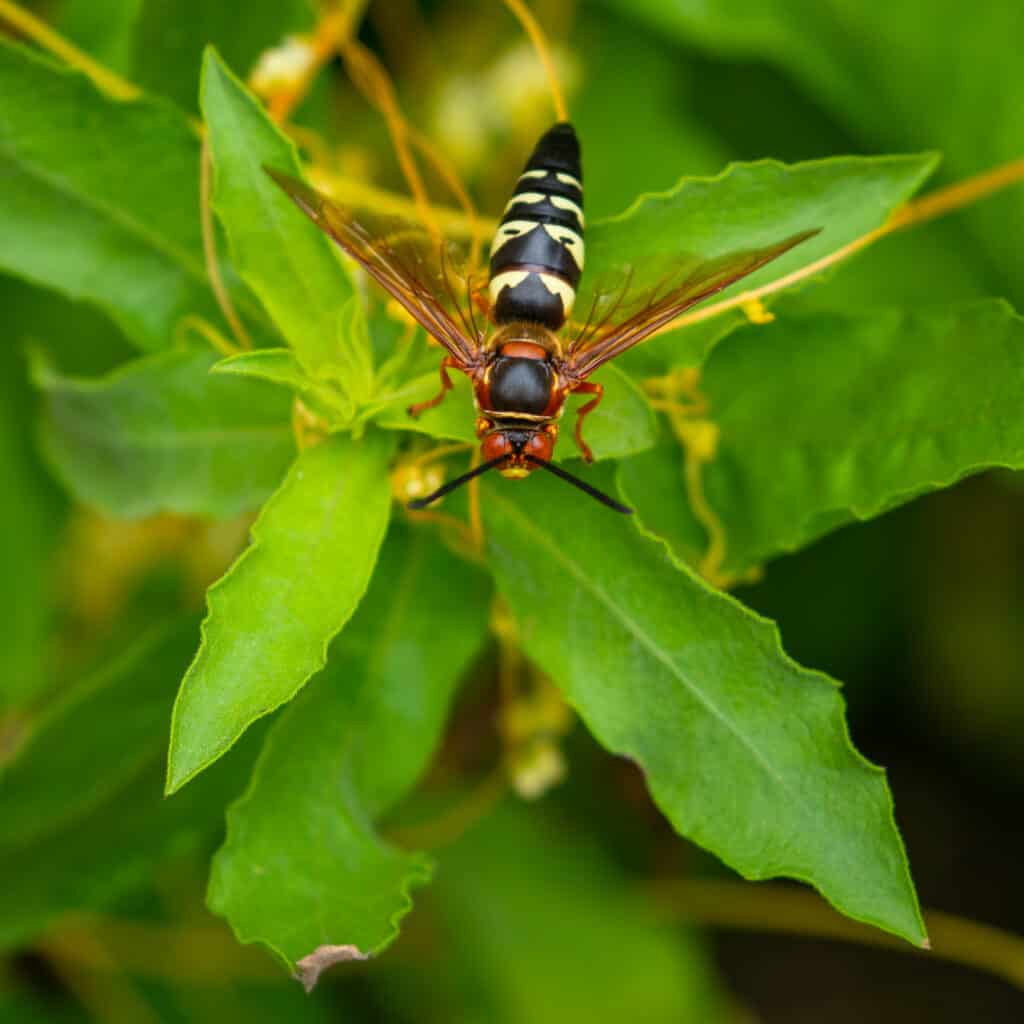
When it comes to hunting, cicada killer wasps are quite efficient.
©iStock.com/Art Sublimina Photography
These large, black, and yellow wasps are often feared due to their imposing size and reputation as predators of cicadas. However, there’s much more to these fascinating insects than meets the eye.
To begin with, cicada killer wasps are solitary creatures, meaning they don’t live in colonies like other types of wasps. They spend most of their lives alone, hunting for cicadas to bring back to their nests.
When it comes to hunting, cicada killer wasps are quite efficient. They use their powerful mandibles to grasp their prey, then inject it with venom to immobilize it. Once the cicada is paralyzed, the wasp will fly back to her nest, which she has carefully constructed in the ground.
But cicada killer wasps aren’t just fearsome predators. They also play an important ecological role. By preying on cicadas, they help to keep populations of these insects in check, which in turn can help to prevent damage to trees and other vegetation.
While these wasps have venom for hunting, they are harmless to humans unless provoked. So, if you see one of these impressive insects in the wild, don’t be afraid – just admire it from a safe distance!
6. Black and Yellow Mud Dauber Wasps
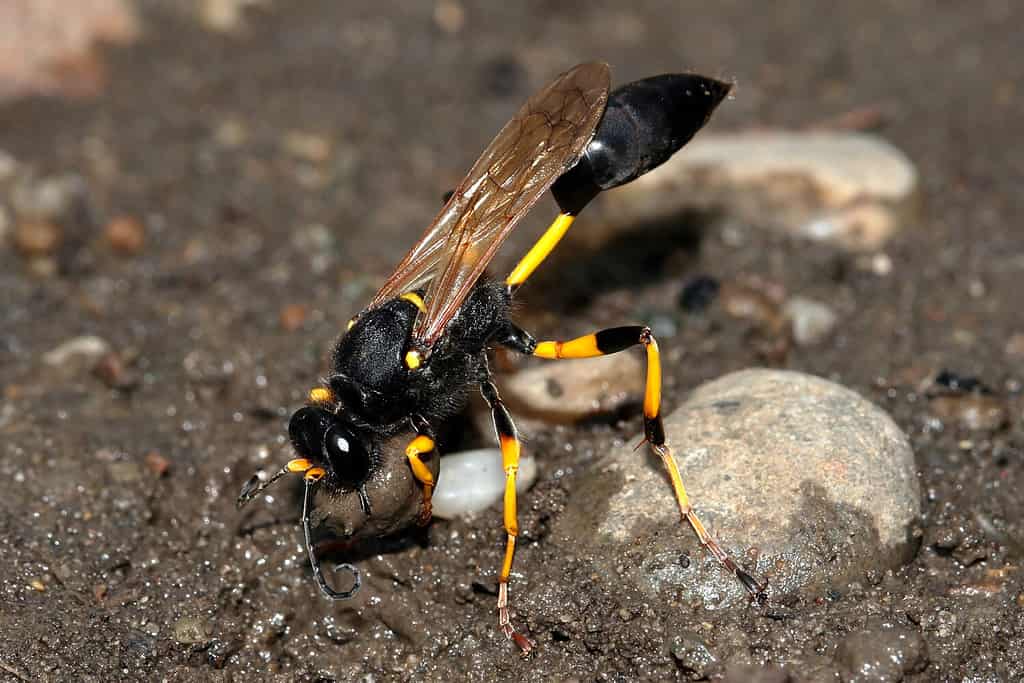
Mud daubers are solitary wasps that build their nests out of the mud.
©Geza Farkas/Shutterstock.com
These wasps, also known as dirt daubers, are known for their distinctive black and yellow coloring and slender, elongated bodies.
Mud daubers are solitary wasps that build their nests out of the mud. They typically create a series of small mud tubes, each containing a single egg and a paralyzed spider or another insect as food for the developing larva.
Unlike other wasps, mud daubers are not aggressive and rarely sting humans. They are quite beneficial, as they help to control spider and insect populations.
Mud daubers are also fascinating to watch. They are very efficient hunters and can often be seen flying low over the ground, searching for spiders to capture and bring back to their nests.
Spider enthusiasts love to break open their nests, where they can find rare spiders. Furthermore, because this species is not very aggressive, this can often be done safely.
7. Thread-Waisted Wasps

During hunting, they immobilize their prey with their deadly stingers before returning it to their nests.
©samray/Shutterstock.com
Thread-waisted wasps, often known as spider wasps, are a remarkable genus of insects with striking black and yellow colors. Unlike many other wasp species, they have an extremely narrow waist that resembles a stalk. These wasps are well known for their hunting ability, as they seek out and capture spiders to feed their young.
During hunting, they immobilize their prey with their deadly stingers before returning it to their nests. The sting of the thread-waisted wasp is regarded as relatively mild for humans, but it can be extremely severe for their spider prey.
Interestingly, thread-waisted wasps have a unique way of securing their prey for their offspring. They will sting the spider on a specific nerve that immobilizes only its legs, making it easier to transport.
These wasps are found worldwide, and there are over 4,000 known species. They are solitary creatures and typically nest in soil or hollow plant stems. Despite their fearsome hunting abilities, thread-waisted wasps are not aggressive toward humans and only sting in self-defense.
8. Cuckoo Wasps
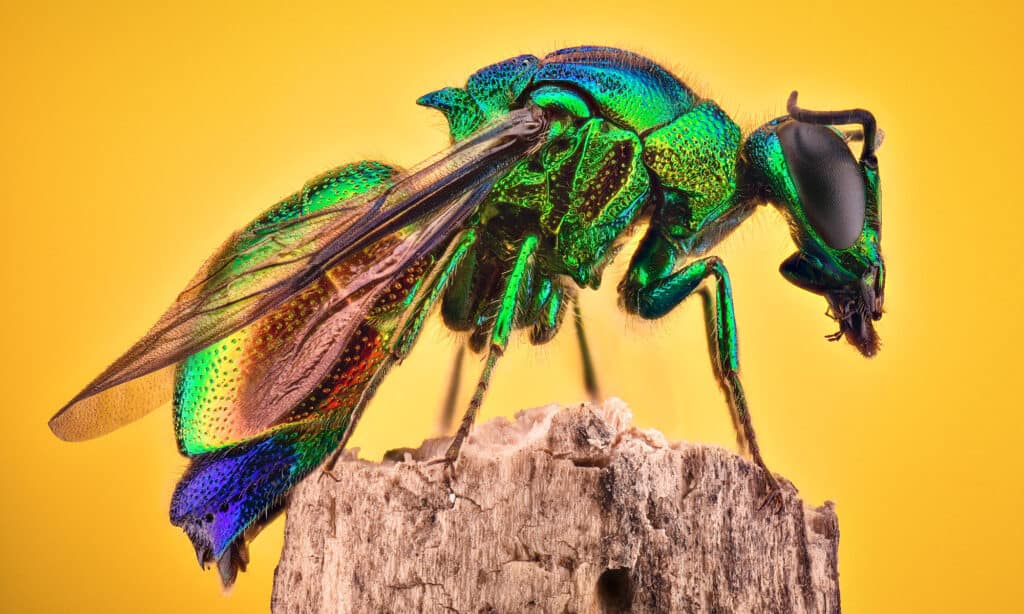
Cuckoo wasps get their name from their behavior, similar to that of cuckoo birds, which deposit their eggs in the nests of other bird species.
©Cornel Constantin/Shutterstock.com
They are a fascinating and colorful group of insects. With their black and yellow or metallic blue-green bodies, they are hard to miss.
The female of these wasps will lay her eggs in the nests of other wasps or bees, known as parasitism. Cuckoo wasps get their name from their behavior, similar to that of cuckoo birds, which deposit their eggs in the nests of other bird species.
Unlike some other wasps, cuckoo wasps do not sting and are not hostile toward humans. They are usually active throughout the day and live in various settings, including gardens, meadows, and woodlands.
They are also significant pollinators, with some species preferring certain types of flowers.
Cuckoo wasps have a distinct look and behavior, making them an intriguing research subject for entomologists and nature enthusiasts.
They are distinguished by their long and thin waists, which give rise to their scientific name, Chrysididae. These wasps are very appealing and fulfill vital ecological roles in their surroundings.
9. Velvet Ants (Cow Killers)
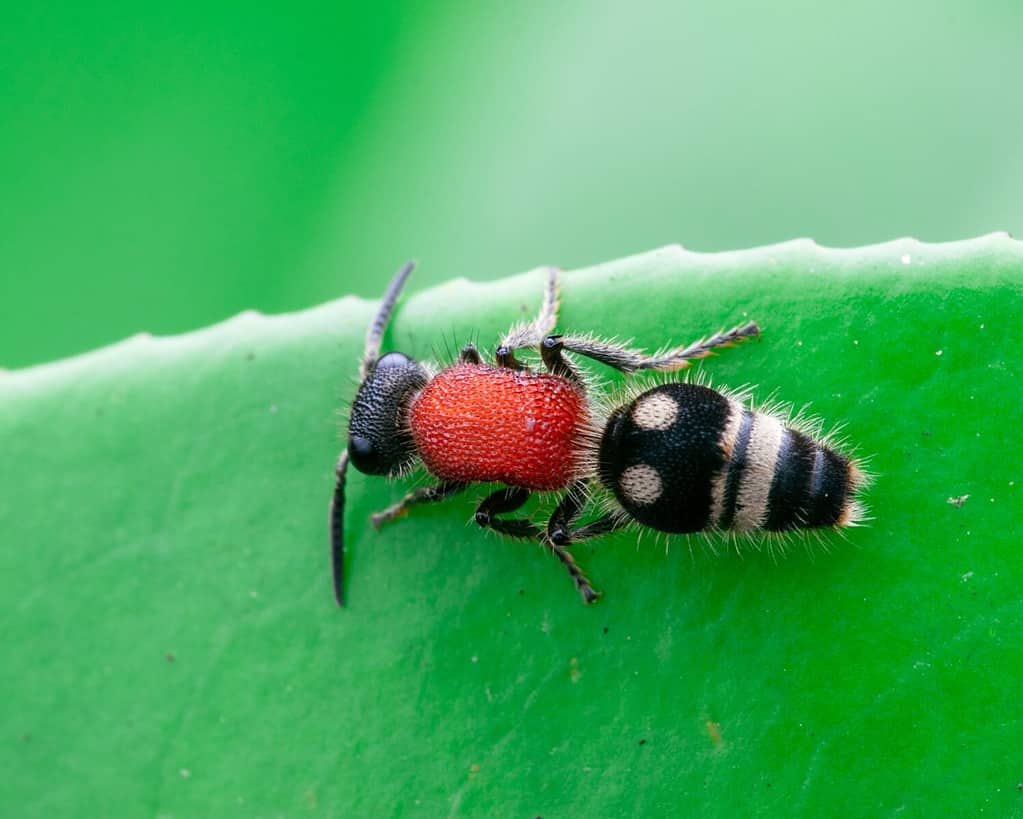
Despite their imposing appearance, velvet ants are not aggressive toward humans and generally avoid confrontation.
©RyanPictures/Shutterstock.com
Velvet ants, also known as “cow killers,” are not ants but rather a type of wasp with a furry, velvety appearance. They are typically black and orange or black and red, although some species may have yellow or white markings. These striking colors warn potential predators that velvet ants should not be messed with.
Despite their imposing appearance, velvet ants are not aggressive toward humans and generally avoid confrontation.
They are parasitic, with female velvet ants laying their eggs on the larvae of other insects, such as bees and wasps. The larvae of the velvet ant will then feed on the host insect’s larvae until it pupates and emerges as an adult.
Velvet ants can be found worldwide but most commonly in warmer climates. They are often seen running along the ground or on vegetation and are active during the day.
Their hairy bodies and legs help them to climb and cling to surfaces, while their powerful mandibles allow them to tear through the tough outer shells of their prey.
10. Great Golden Digger Wasps
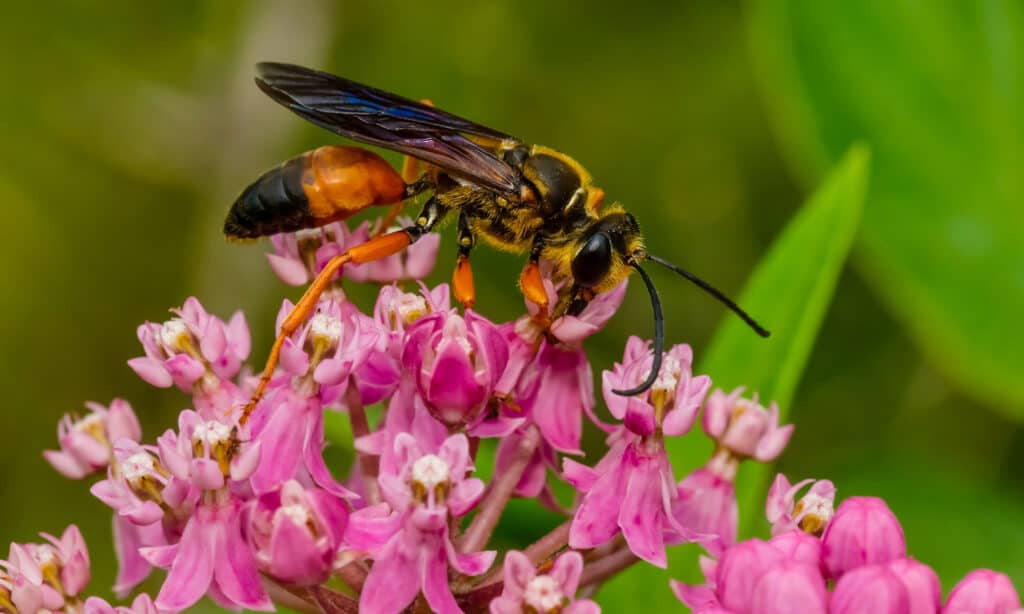
Great golden digger wasps are considered beneficial insects, they help control the population of cicadas, which cause damage to trees and plants.
©Paul Reeves Photography/Shutterstock.com
They are also known as “cicada hawks,” are one of the largest and most striking wasps in North America. These wasps have a distinct black and yellow striped pattern, with a shiny metallic golden color on their body.
They are named “cicada hawks” due to their hunting behavior, as they prey on cicadas, which they paralyze and bring back to their nests to feed their young.
Female great golden digger wasps are responsible for hunting cicadas and building nests. They are solitary wasps and do not live in colonies like other social wasps.
These wasps are known for their impressive digging skills, as they excavate underground burrows for their nests using their strong mandibles.
Despite their imposing size and hunting habits, great golden digger wasps are not aggressive toward humans and will only sting if provoked or threatened. They are considered beneficial insects, as they help control the population of cicadas, which can cause damage to trees and plants.
11. Bald-Faced Hornet

Despite their fearsome reputation, bald-faced hornets play an important role in their ecosystems by controlling insect populations.
©Ernie Cooper/Shutterstock.com
The bald-faced hornet is a formidable and striking creature with a unique black-and-white appearance. It’s not a true hornet, but rather a type of yellow jacket wasp. These wasps get their name from the bald patch on their heads, devoid of the usual black and yellow stripes found on the rest of their bodies.
Bald-faced hornets are known for their impressive paper nests, which they construct by mixing their saliva with wood fibers to create a papery substance. These nests can be large and usually hang from trees, bushes, or buildings.
Despite their intimidating appearance, bald-faced hornets are generally not aggressive unless their nest is threatened.
Regarding food, bald-faced hornets are carnivorous and feed on various insects, including flies, caterpillars, and other small arthropods. They also have a bit of a sweet tooth and have been known to scavenge sugary substances like fruit juice and soda.
Like other social wasps, bald-faced hornets live in colonies with a queen and several worker wasps. The queen lays eggs, and the workers care for the young and defend the nest.
New queens and males are produced in the fall, and they mate before the old colony dies off. The new queens then hibernate for the winter and start new colonies the following spring.
Despite their fearsome reputation, bald-faced hornets play an important role in their ecosystems by controlling insect populations and serving as food for other animals. Plus, their impressive nests are a marvel of natural engineering.
12. Yellow-Legged Mud Dauber Wasps
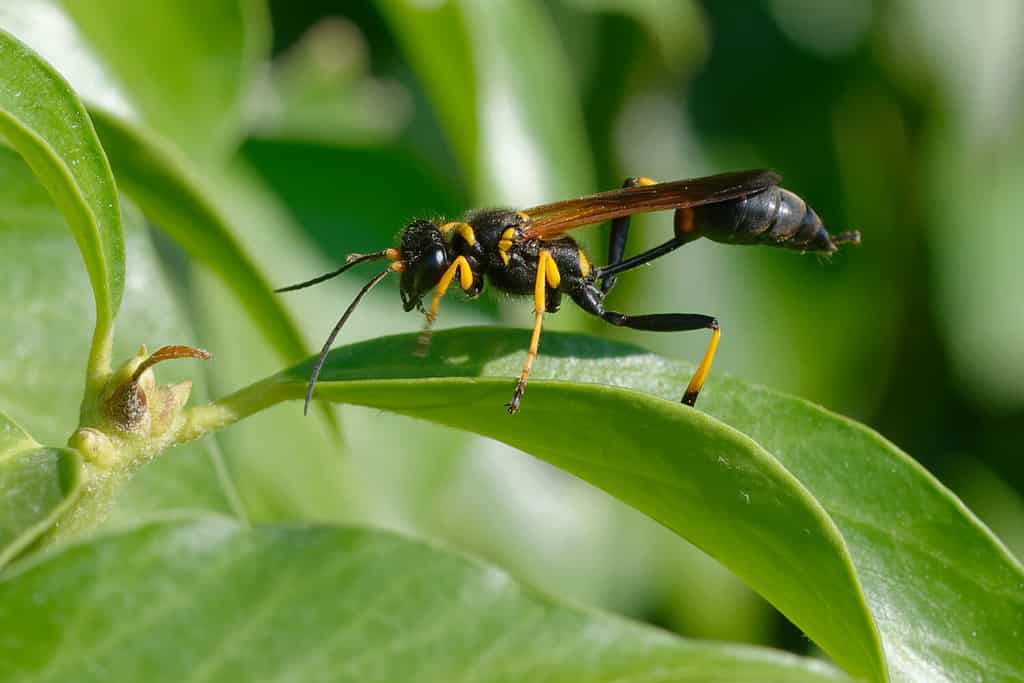
Despite their intimidating appearance, yellow-legged mud daubers are harmless to humans and typically avoid confrontation unless provoked.
©LABETAA Andre/Shutterstock.com
These wasps are easily identifiable by their slender, black bodies and bright yellow legs, which transport mud during their nest-building process.
Despite their intimidating appearance, yellow-legged mud daubers are harmless to humans and typically avoid confrontation unless provoked. They are solitary wasps that prefer to live alone, although they may build multiple nests near each other.
When it comes to nest-building, yellow-legged mud daubers are highly skilled. They collect mud in small balls, which they transport back to their nest using their powerful mandibles.
Once the mud is collected, the wasp uses it to create intricate tubes that serve as the foundation for the nest.
But what makes yellow-legged mud daubers truly unique is their hunting behavior. These wasps specialize in hunting spiders, which they paralyze with a venomous sting before dragging them back to their nest as food for their young. The wasps then lay eggs on the paralyzed spiders, which serve as nourishment for the developing larvae.
13. European Paper Wasps
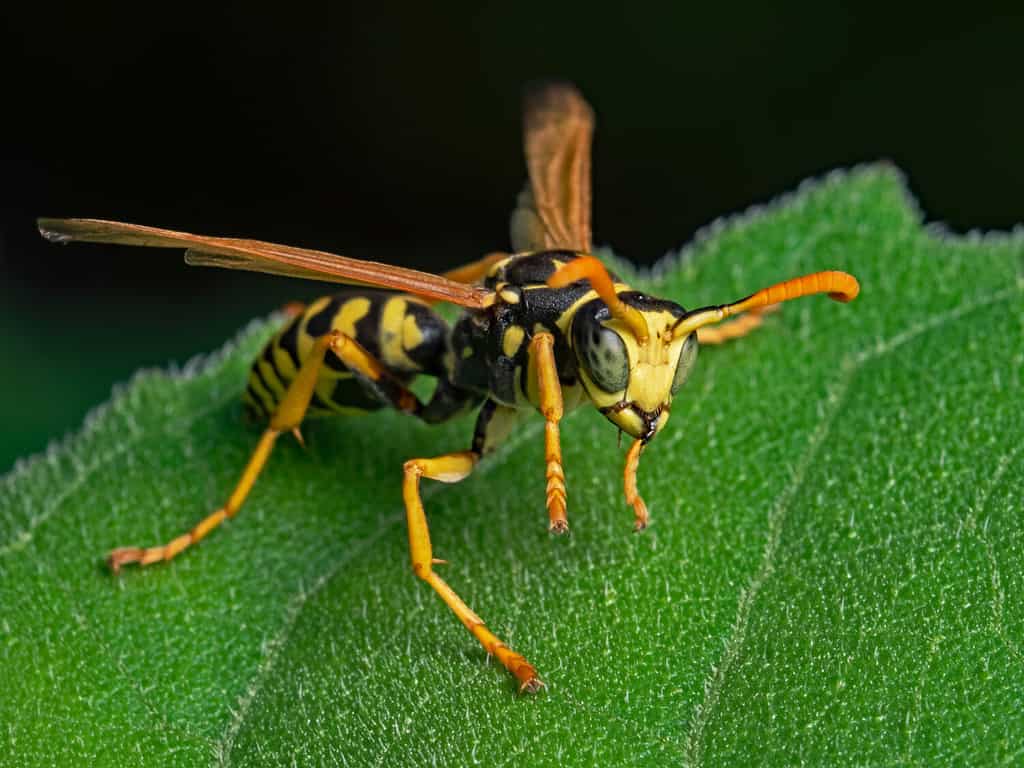
The European paper wasp is a social species with a queen, female workers, and male drones.
©scubaluna/Shutterstock.com
A closer look reveals they are very ordered and efficient in their daily chores. They are not naturally aggressive but will sting if confronted or their nest is damaged. They are, however, generally calm and will not attack unless provoked.
The European paper wasp is a social species with a queen, female workers, and male drones. The queen is the colony’s leader, and her main job is to lay eggs.
Female workers are responsible for various duties, including caring for the young, constructing and maintaining the nest, and hunting for food. Male drones are responsible for mating with the queen.
Female workers perform various tasks, such as caring for the young, building and maintaining the nest, and foraging for food. Male drones are responsible for mating with the queen.
These wasps are also known for their remarkable building skills. They construct their nests from saliva and wood fibers, creating a sturdy and intricate structure. The nests are typically located in protected areas, such as eaves, tree branches, and other outdoor structures.
14. Red-Banded Paper Wasps

What sets the red-banded paper wasp apart is its aggression.
©Natalia Kuzmina/Shutterstock.com
The red-banded paper wasp is a fascinating species that may be found across much of North America. This wasp sticks out from the throng with its striking reddish-brown body and vivid yellow bands.
Like other paper wasps, they live in colonies with a single queen and many female workers. The queen is in charge of laying eggs, while the workers are in charge of constructing and maintaining the nest and acquiring food.
But what sets the red-banded paper wasp apart is its aggression. These wasps can be quite territorial and often attack anything they perceive as threatening their colony. This can include people who get too close to their nest or even other insects that happen to cross their path.
Despite their reputation for being aggressive, red-banded paper wasps are quite beneficial. They are predators that primarily feed on other insects, including caterpillars, grasshoppers, and even other wasps. This makes them valuable for controlling pest populations in gardens and other outdoor spaces.
15. Black and Yellow Spider Wasp
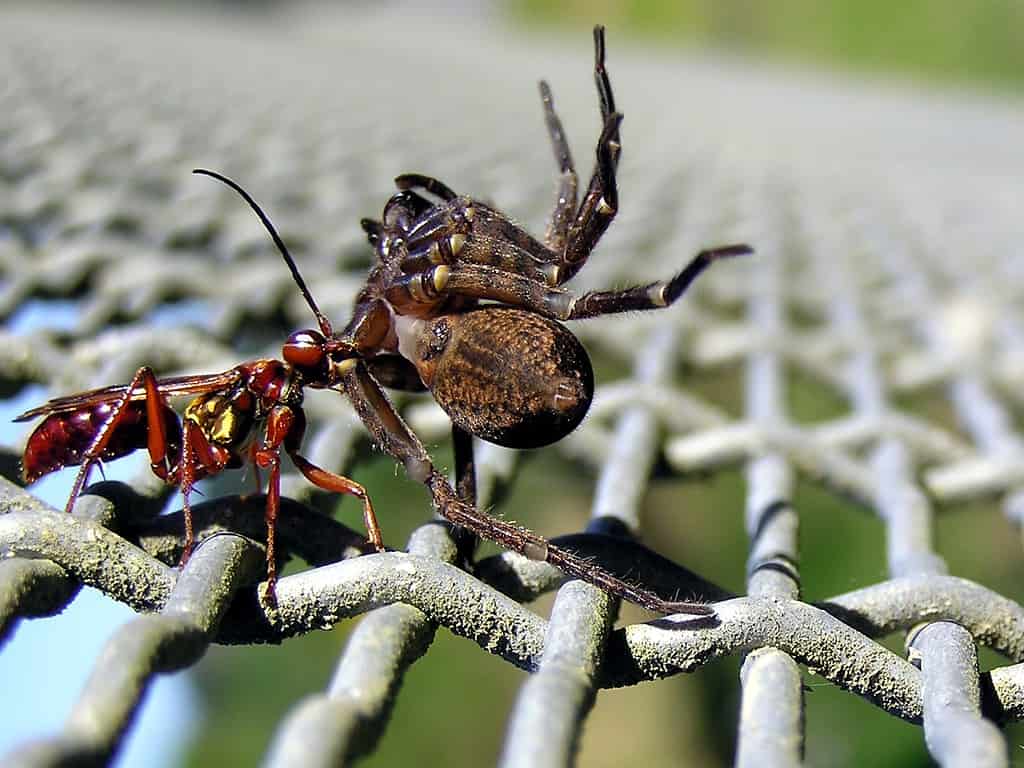
Being a wasp, I must say that the black and yellow spider wasps are among the most effective predators I’ve ever seen.
©1,601 × 1,200 pixels, file size: 614 KB, MIME type: image/jpeg – License
Black and yellow spider wasps, sometimes known as golden spider wasps, are among the most enthralling insects. They are called for their distinct hunting style, which involves paralyzing spiders with deadly stings and dragging them back to their nests.
Being a wasp, I must say that the black and yellow spider wasps are among the most effective predators I’ve ever seen. They have powerful wings and strong mandibles that allow them to readily grab and carry prey.
These wasps prey on a wide range of spiders, from the small and delicate to the huge and hairy.
The black and yellow spider wasps are distinguished by their extraordinary ability to locate and identify spiders. Female wasps have a keen sense of smell and can detect spiders from a long distance. Once they’ve discovered their victim, they sedate it with a series of precise maneuvers before transporting it.
Despite their formidable hunting abilities, black and yellow spider wasps are rarely violent toward humans. They are quite shy and will only sting if disturbed or threatened.
These wasps have also recognized pollinators, as they visit flowers in quest of nectar and pollen.
What Happens if You Get Stung by a Bald-Faced Hornet?

Bald-faced hornets have smooth stingers and are able to sting multiple times.
©Paul Reeves Photography/Shutterstock.com
Bald-faced hornets are a species of wasp that live in social colonies of around 400 individuals. They have a positive impact on the environment and our ecosystem and they typically will pose no threat to humans when their nests are located away from high-traffic human areas. However, if they are close to areas that see frequent human traffic, such as doorways and walkways, this can potentially lead to a higher sting risk, which if you are allergic could have severe consequences.
Bald-faced hornets will aggressively defend their nests and their stings are quite painful. They are also able to sting repeatedly, unlike honeybees who will die after stinging one time. Their venom may cause allergic reactions or infections that can be life-threatening. Generally, though, these stings, however painful they may be, will only cause minor discomfort in most people.
Should you get stung, you should first remove the stinger, then wash the area with soap and water, and if necessary, apply ice on the affected area to reduce swelling. Should you experience signs of a serious reaction and need medical attention, call 911 immediately.
The photo featured at the top of this post is © JorgeOrtiz_1976/Shutterstock.com
Thank you for reading! Have some feedback for us? Contact the AZ Animals editorial team.






